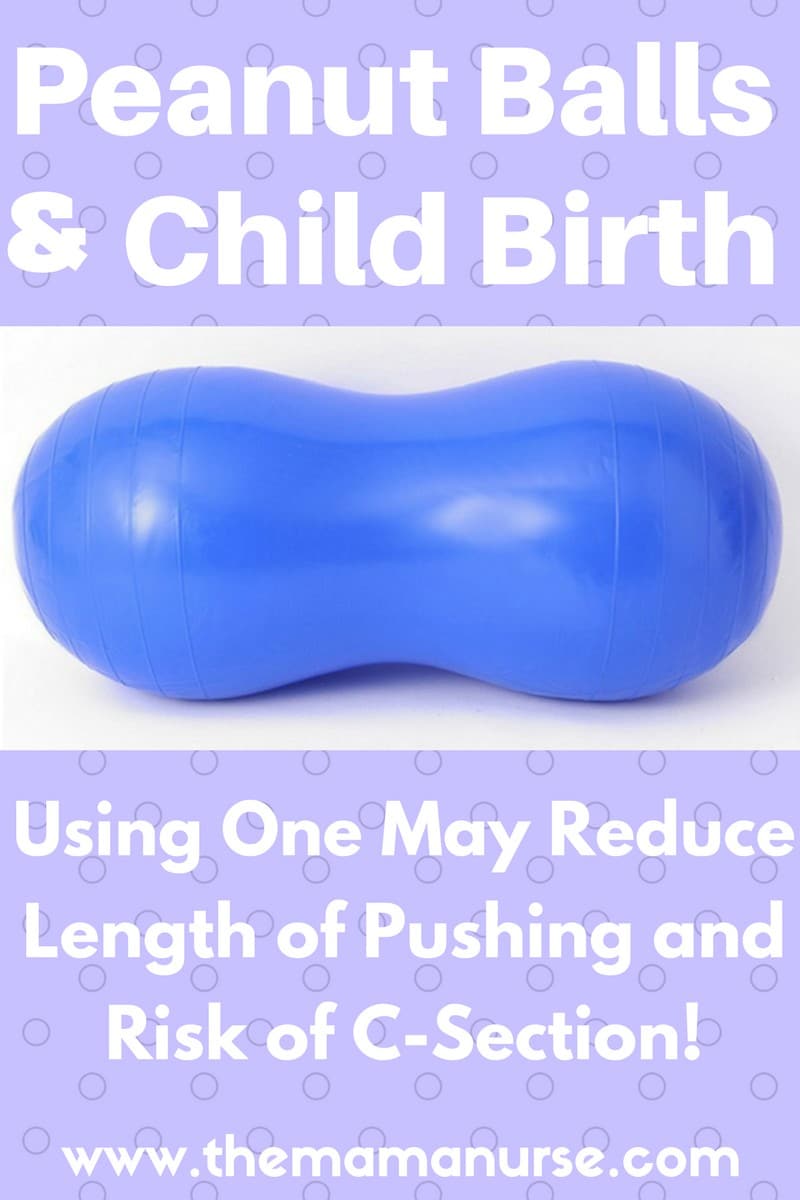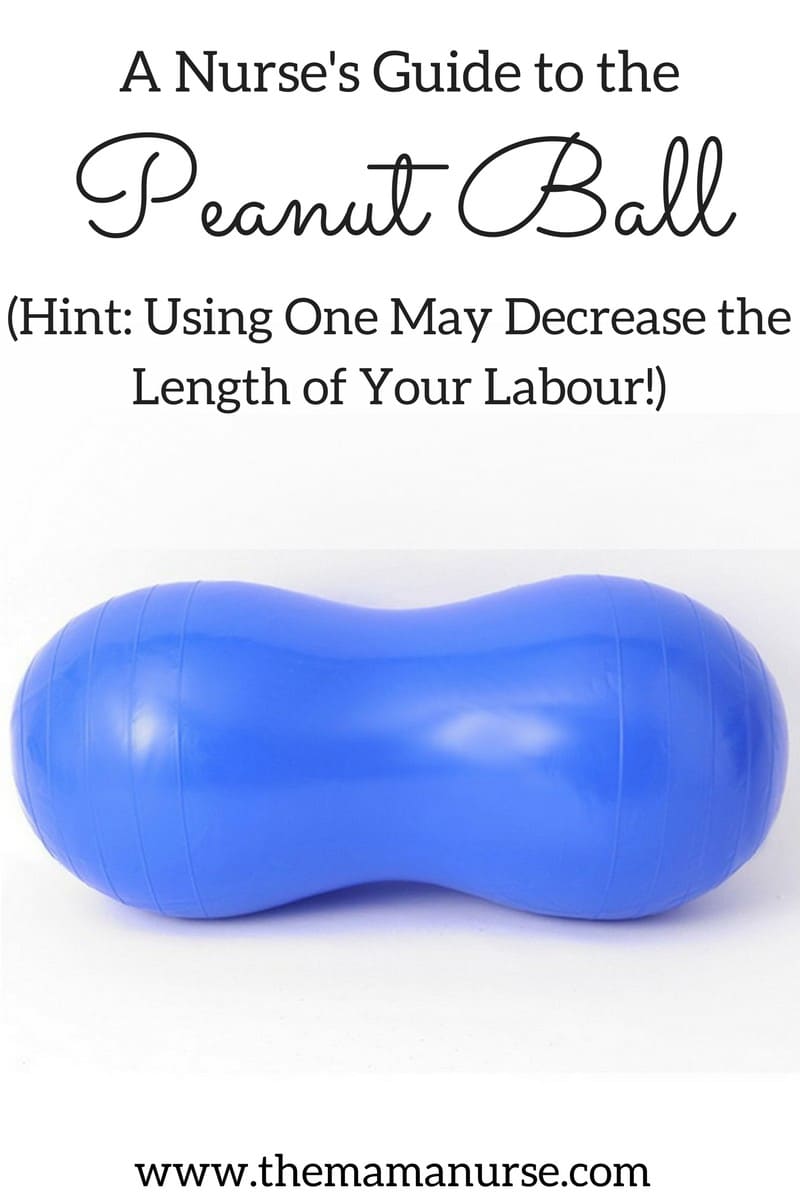Our hospital recently purchased some peanut balls to use during labour support. There is nothing that quite excites a labour and delivery nurse more than finding a new tool that may help our patients deliver their babies more easily and comfortably!
Birthing balls have been commonplace in labour suites for years, but for many pregnant women, the thought of using a peanut ball during labour has not crossed their minds. According to recent research, it may be worthwhile for readers like you to become aware of the peanut ball and its potential benefits of use!
What is a Peanut Ball?
Well, as the name implies, it is a medicine ball the shape of those delicious salty snacks served in a bar near you. In more descriptive words, it is an oblong-shaped inflated ball that is bigger on the sides and narrower in the middle.
How is a Peanut Ball Used in Labour?
The peanut ball is used when a labouring mom is lying down, whether she has an epidural or because of exhaustion. In one position, she can lie on her side and place the peanut ball between her legs. It is also used while lying back slightly, with one leg on top of the ball and the other leg resting to the side.
What is the Purpose of a Peanut Ball?
During childbirth, three important things must happen. The cervix (the tissue that normally separates the uterus from the vagina) thins, dilates, and baby’s head slowly progresses down the birth canal. In order for this labour progression to occur without issue, the back of baby’s head (or bum, which of course isn’t ideal) must press down against the cervix, and there must be enough room in the pelvis to allow for descent. This is why when a woman’s water breaks and there no longer is a cushion of amniotic fluid between the baby’s head and the cervix, contractions normally become stronger and labour progresses at a faster rate. Unfortunately this is also why labour can stall if a mom is unable to relax her pelvic muscles due to pain or anxiety, or if baby’s head is not correctly positioned.
The general thought process of why a peanut ball assists mothers lying down during labour, is that it was allow a mom’s legs to relax around the peanut ball while also opening the pelvic outlet enough to let the baby’s head come down.
What Does the Research Say About the Peanut Ball?
The Journal of Perinatal Education published a study in 2015 (SOURCE) that looked at whether labouring moms with epidurals using a peanut-shaped exercise balls would reduce labour times and the chances of requiring a cesarean section.
The results of the study demonstrated that using a peanut ball during labour does indeed have a significantly shorter length of the pushing stage, and the ceasarean kamagra india buy section rate was statistically lower than those who did not use a peanut ball. In addition, the need to induce and augment as well as the use of forceps and vacuums were lower with the use of the peanut ball group. However, the difference was not statistically significant.
Conflicting Studies?
The whole premise of using a peanut ball during labour may seem odd to begin with, but if we take a hard look at what epidurals do and the natural process of labour, you will easily be able to see why peanut balls are cropping up in birthing centres all over North America. First of all, what happens when our patients receive an epidural? With an epidural, patients lose sensation of pain in the lower half of their bodies, usually only feeling pressure during contractions and pushing. It is clearly the most effective means of pain-relief during labour, but it also has an small, irritating side effect: It decreases sensation in the legs so much that it is impossible to move. In theory, this decreased movement during labour, decreased pushing sensation and increased interventions used (IV therapy, continuous fetal monitoring) could increase caesarean section rates by cause of a failure to progress or fetal distress (whether perceived or clear).
However, the current standing of the ACOG (American Congress of Obstetricians and Gynaecologists) is that based on recent studies, epidurals do not increase the caesarean section rate (SOURCE). The ACOG (2006) states, “ The fear of unnecessary cesarean delivery should not influence the method of pain relief that women can choose during labor”.
Thus, there appears to be a disconnect as to how exactly the peanut ball decreases caesarean sections and length of pushing, if studies are also showing the epidural therapy does not increase caesarean section rates. To me, you wouldn’t be able to demonstrate a statistically significant benefit to using a peanut ball, if lying in bed did not negatively effect the natural childbirth process.
Conclusion
Overall, the results of the 2015 peanut ball study show a lot of promise, and I hope that more research focuses on whether its use in labour is indeed beneficial. I look forward to using the peanut ball in my own practice as a labour nurse, and I hope you as readers keep an open mind if you are ever given an opportunity to try one out.
P.S. If you’re interested in using a peanut ball but your labour & delivery ward does not supply them, you can find them in the exercise section in-store or on websites like Amazon for reasonable prices! (Check one out here)
Now that you’re informed for your birth, are you ready to learn more about breastfeeding? Book a one-on-one prenatal breastfeeding education session with me online.






0 Comments
Trackbacks/Pingbacks